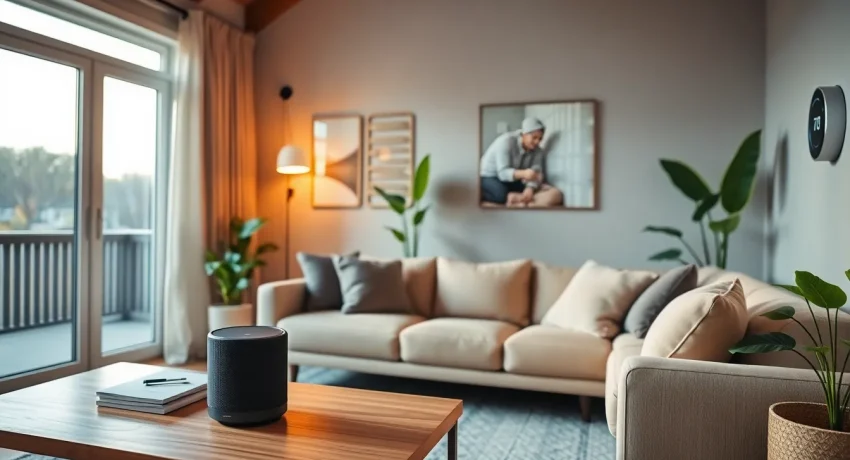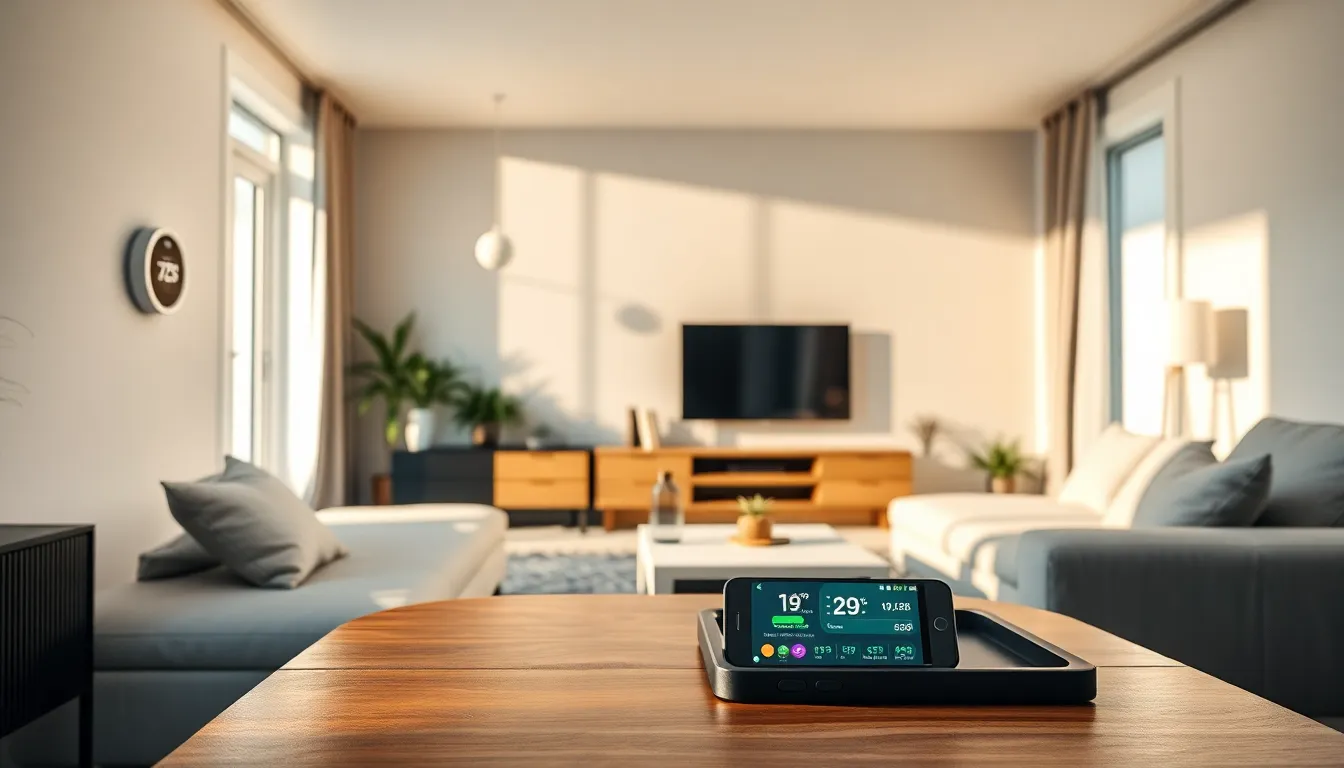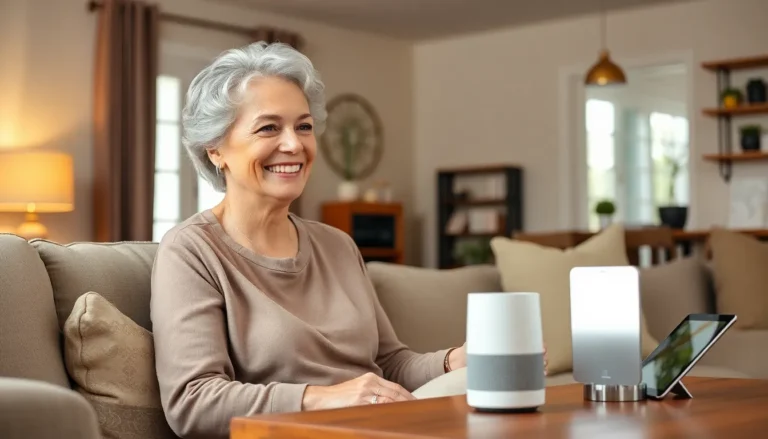Table of Contents
ToggleImagine stepping into your home and being greeted by the perfect temperature, soft lighting, and your favorite playlist playing in the background. Sounds like a scene from a sci-fi movie, right? Well, welcome to the world of smart home comfort settings, where technology transforms everyday living into a luxurious experience.
Overview of Smart Home Comfort Settings
Smart home comfort settings utilize technology to enhance living spaces. They adjust temperature, lighting, and sound based on user preferences. For instance, smart thermostats enable automatic temperature control. When occupants leave or arrive home, these devices maintain ideal comfort.
Automated lighting systems create ambiance through customizable settings. Users can select brightness levels and color tones, ensuring spaces reflect mood. Voice control options add convenience, allowing adjustments without physical interaction.
Personalized music plays a significant role in comfort. Smart speakers connect to streaming services, playing desired playlists or genres. Users enjoy tailored soundscapes during activities like reading, entertaining, or relaxing.
Smart home comfort extends beyond the basics. Integration with other devices enhances experiences. For example, a smart home hub coordinates multiple devices, creating routines that automate actions. Upon waking, a user might experience gradually brightening lights and warming temperatures.
Energy efficiency stands out among advantages. Many smart devices optimize usage, reducing energy bills. Certain systems learn user habits, adjusting settings to conserve energy during inactive times.
Security also benefits from smart comfort settings. Smart cameras and alarms help ensure safety while enhancing peace of mind. Homeowners can monitor surroundings and respond promptly to alerts.
Overall, smart home comfort settings combine technology with user preferences. They create tailored environments that promote relaxation, enhance security, and improve energy efficiency.
Benefits of Smart Home Comfort Settings
Smart home comfort settings provide various advantages, including energy efficiency and convenience in everyday life.
Improved Energy Efficiency
Smart devices significantly enhance energy efficiency. Thermostats learn user preferences, adjusting temperatures automatically. For example, a smart thermostat can lower heating and cooling costs by up to 20%. Lighting systems can also optimize energy use, turning off automatically in unoccupied rooms. Sensors detect when occupants are present, ensuring lights only operate as needed. Many devices provide real-time usage statistics, helping users understand consumption patterns. Such insights enable informed decisions about energy-saving practices. Ultimately, smart home technology promotes a sustainable lifestyle by conserving energy and reducing utility expenses.
Enhanced Convenience
Convenience is another major benefit of smart home comfort settings. Homeowners control various devices remotely using smartphones or voice commands. Automation simplifies daily routines by allowing users to create schedules for heating, lighting, and music. For instance, setting a morning routine might automatically raise the blinds, turn on the coffee maker, and adjust the thermostat. Smart hubs streamline device coordination, enabling seamless integration across systems. Notifications keep users informed about home conditions, providing peace of mind. Such enhancements lead to a more comfortable, personalized living environment that caters to individual needs.
Popular Smart Home Devices and Systems
Smart home technology includes a variety of devices that enhance comfort settings for users. Key categories such as thermostats, lighting control systems, and smart curtains and blinds offer significant improvements in energy efficiency and convenience.
Thermostats
Smart thermostats streamline climate management by automatically adjusting temperatures based on occupancy patterns. These devices learn homeowner habits, maximizing energy savings. According to the U.S. Department of Energy, users can reduce heating and cooling costs by up to 20% with these systems. Remote access options allow users to change settings from anywhere, ensuring comfort upon arrival at home. Many models also provide real-time energy usage reports, helping users make informed decisions regarding their habits.
Lighting Control
Lighting control systems offer tailored ambiance through programmable settings. Users can select from various brightness levels and color tones that suit different activities. Smart bulbs, which are often integrated with home automation, allow for seamless adjustments via smartphones or voice commands. This flexibility enables users to create schedules or scenes that match daily routines. The energy efficiency of smart lighting can lead to significant savings, as systems automatically turn off lights in unoccupied spaces.
Smart Curtains and Blinds
Smart curtains and blinds contribute to comfort by regulating natural light and privacy effortlessly. Automated systems adjust according to the time of day or user preferences, optimizing indoor environments. For example, they can block sunlight during peak hours to maintain a cool temperature or open during mornings to let in natural light. Many options are compatible with existing smart home hubs, allowing for centralized control alongside other devices. This integration enhances the overall convenience and customization of living spaces, making everyday life easier for users.
Customizing Your Smart Home Comfort Settings
Customizing smart home comfort settings allows users to create personalized spaces that cater to individual tastes and habits. This enhances leisure and promotes well-being at home.
User Preferences and Profiles
User preferences shape the smart home experience significantly. Smart devices can create multiple user profiles, enabling tailored settings for each household member. For instance, one profile may maintain cooler temperatures during the night, while another prefers warmth in the morning. Lighting adjustments also cater to different tastes, allowing varied brightness and color tones. Music playlists can differ based on user profiles, enhancing everyday activities such as cooking, exercising, or relaxing. By prioritizing individual needs, smart homes turn everyday living into a more enjoyable experience.
Automation and Scheduling
Automation and scheduling streamline daily routines, making life easier. Smart devices can pre-program settings, optimizing comfort even when users are away. For example, lighting can dim, and the thermostat can adjust before a family arrives home. Scheduling allows for energy savings; devices operate efficiently based on user habits. Smart curtains can open with the sunrise, letting in natural light, while music can play at specified times. These automated actions create a seamless experience, ensuring homes remain comfortable and convenient for all occupants.
Conclusion
Smart home comfort settings revolutionize the way individuals experience their living spaces. By seamlessly integrating technology into daily routines, these systems offer unparalleled convenience and personalization. Homeowners can enjoy tailored environments that respond to their preferences while promoting energy efficiency and enhancing security.
As smart devices continue to evolve, the possibilities for creating comfortable and inviting spaces will only expand. Embracing this technology not only enriches daily life but also fosters a sustainable lifestyle. With smart home comfort settings, achieving the perfect ambiance has never been easier or more efficient.





